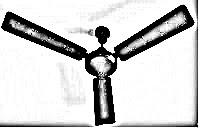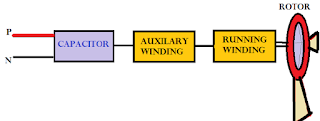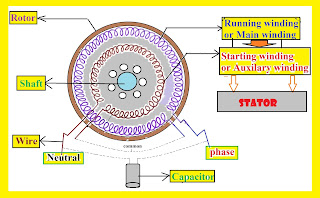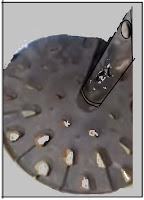Do you Know? A ceiling fan is a vital household item used all over the world, and it is also an interesting engineering topic to discuss.
As an electrical engineer, I recommend every person to know about the working principle of a ceiling fan, which will pique their interest in learning about the electrical motor.
The working principle of the ceiling fan outlined here applies to all ceiling fan brands, including Bajaj, Orient, and Khaitan makes.
- What is a ceiling Fan?
- Construction and working principle of the ceiling fans,
- What are the major parts of ceiling fans? and
- The circuit diagram of a ceiling fan.
- Why Capacitor is required for ceiling fan.
What is a Ceiling fan?
The term "ceiling fan" refers to a rotatory electrical device mounted on the ceiling vertically, providing continuous airflow that can be felt on our skin.
This ceiling fan rotates and distributes air throughout the room in all directions improving comfort during hot wheather.
In general, an energy-efficient ceiling fan uses less power, but they are more expensive costs.
A typical local ceiling fan consumes a lot of power, ranging from 45 to 70 watts.
Did you know? (ceiling fan direction)
Ceiling fans in India rotate anticlockwise, while ceiling fans in Australia rotate clockwise. Anticlockwise rotation is for hot weather and clockwise direction for cold weather. Depending on usage the ceiling fans are manufactured.
Traditional ceiling fans have been given new designs and structures thanks to modern technology. e.g. superfan, Anderson enclosed fan with light. Superfan uses a brushless DC motor (BLDC) and it is remotely operated.
You can also skip directly to the topic "how ceiling fans work?" on down.
Ceiling fan motor
What if your neighbors ask some questions about the ceiling fan's motor?
The ceiling fan's motor is a single-phase induction motor, but due to the following factor, it has a variety of names.
We have all heard of single-phase induction motors and their various types. The ceiling fan is also rotated by a single-phase induction motor.
The ceiling fan requires a capacitor because the motor is not self-starting. As a result, the motor is referred to as a capacitor split-phase starting motor.
Construction of single-phase induction motor
A single-phase induction motor typically has two windings: one for starting and the other for running.
Other names
Because of the capacitor in the single-phase induction motor of a ceiling fan, it is also known as a "capacitor split-phase motor" or capacitor motor.
Capacitor split-phase motor is also one type of induction motor consists of main and auxiliary winding.
The capacitor split motor is also called a split-phase starting motor.
Ceiling fan circuit diagram
Because the circuit of the capacitor split-phase has only four basic elements, a ceiling fan circuit diagram is simple to understand. As a result, the assembly of a ceiling fan is simple. The ceiling fan circuit diagram is shown below.
The circuit diagram of the ceiling fan has these three important components
- Main Winding
- Auxiliary winding
- Capacitor or condenser
- Rotor
Ceiling Fan Working Principle
The ceiling fan's operation is based on the law of electromagnetic induction. The ceiling fan's induction motor converts electrical energy into mechanical energy. The most of the ceiling fan motor requires a 250v single-phase alternating current supply but this may vary depending on specific model.
A single phase induction motor initially generate a pulsating magnetic field in the winding which does not lead to self starting rotation. To overcome this limitation, the motor requires a capacitor to make angle phase differences creating a rotating magnetic field.
A rotating magnetic field is the essential for the motor operation.
Pulsating magnetic field - The magnetic field builds in one direction, reaches the maximum, becomes zero, then reverse direction reaches another maximum, becomes zero again. The same process continues to repeat in a cyclic manner.
Characteristics of current and voltage for rotating force
Running winding requires a leading current (current leads voltage) to create torque (rotating force) on the rotor. This is accomplished by permanently connecting the start and run type capacitor to the auxiliary winding during start and run conditions.
The series capacitor provides a 90 ° phase shift to the current and voltage. Due to variation in the phase angle of current and voltage the changing magnetic field creates torque in the rotor. The torque in the wind moves the rotor from one pole to the next pole.
The mechanical force of the motor efficiently utilizes the law of aerodynamic with the help of blades on a ceiling fan which is attached to the housing of the rotor.
A concept related to the working principle of the ceiling fan are:
Aerodynamic behind the airflow
The air moves downward as the blades rotate anticlockwise. When the fan blade rotates, the curvature of the blade collides with the air particles and pushes them downward.
The ceiling fan's operation is based on the law of electromagnetic induction. The ceiling fan's induction motor converts electrical energy into mechanical energy. The most of the ceiling fan motor requires a 250v single-phase alternating current supply but this may vary depending on specific model.
A single phase induction motor initially generate a pulsating magnetic field in the winding which does not lead to self starting rotation. To overcome this limitation, the motor requires a capacitor to make angle phase differences creating a rotating magnetic field.
A rotating magnetic field is the essential for the motor operation.
Pulsating magnetic field - The magnetic field builds in one direction, reaches the maximum, becomes zero, then reverse direction reaches another maximum, becomes zero again. The same process continues to repeat in a cyclic manner.
Characteristics of current and voltage for rotating force
Running winding requires a leading current (current leads voltage) to create torque (rotating force) on the rotor. This is accomplished by permanently connecting the start and run type capacitor to the auxiliary winding during start and run conditions.
The series capacitor provides a 90 ° phase shift to the current and voltage. Due to variation in the phase angle of current and voltage the changing magnetic field creates torque in the rotor. The torque in the wind moves the rotor from one pole to the next pole.
Speed and Power consumption
The motor's speed determines the requirement of power. The speed of the ceiling fan can be controlled by a regulator.
The voltage can be adjusted with the help of a regulator.
Final steady-state speed
When full current flows into the winding of the ceiling fan, the steady-state speed of the ceiling fan motor can be attained.
The formula for calculating the final steady speed of the fan
N= 120* f/P
P= No of poles of the stator winding
f=Frequency of the supply
N=steady speed
Ceiling Fan Parts and Components
Here I am going to classify the ceiling fan parts into two groups, for better understanding.
- Exterior component
- Interior component
Exterior components
The major components of a ceiling fan are its exterior components. The mechanical strength of a ceiling fan is provided by its external components. We can see the component with our own eyes. Its exterior elements are.
- Mounting bracket.
- Top canopy and down canopy
- A shaft or connecting rod
- Blades and Bracket fitting
- The top cover and bottom cover housing of the motor
Mounting bracket
The mounting bracket functions as a holding arm, holding the ceiling fan vertically downward.
Ceiling fan blades
The ceiling fan should have 3-4 blades and an angle between each blade should be correctly maintained according to the standards (IEC or any other national standards).
The ceiling fan blades are designed in accordance with aerodynamic law because they create airflow when the ceiling fan is in motion. When purchasing a blade, it is important to consider the pitch, shape, and size. A slight downward curvature should be designed into the blade.
The angle between the blades is defined as blade pitch.
Interior components
The interior components can be found within the outermost structure. The ceiling fan's interior components are
A shaft of the ceiling fan
A ceiling fan shaft is a vertical down rod that supports and holds the stator-winding of a single-phase induction motor. The shaft should be 2 to 10 inches long.
The shaft will eventually reach the stator's center. Because it houses the stator, it is a non-rotatable component of the ceiling fan.
Half of the vertical rod is visible to the eyes and the remaining parts are considered interior parts.
Stator and winding of the ceiling fan
The ceiling fan's stator is made of thin laminated sheet metal mounted in a cast-iron frame. For the winding of the coil, the stator has slots with parallel teeth. On the slots and teeth, the two windings are wounded on the same stator. Copper or aluminum is used to make the winding coils. The majority of the company's fan windings are made of copper.
How do you determine starting and running winding of a ceiling fan?
Starting and running winding wire in a ceiling fan can be easily identified by testing the resistance value of the winding wire.
Starting wire will always have a higher resistance value and running winding wire will always have a lower resistance value.
The stator winding of the ceiling fan
On a stator, there are two types of winding: auxiliary winding and main winding. It is also known as starting winding and running winding. The main winding is wound on teeth, while the auxiliary winding is wound on slots.
Ceiling fan's Rotor
The ceiling fan's rotor is the rotating component that revolves around the stator. It appears to be the outermost shell of a stator. It also seems to be around the steel bar. Small air gaps remain between the stator and the rotor, which aids in free rotation or running.
Ceiling fan's Capacitor
The non-polarized electrolytic capacitor is used in the ceiling fan. It is capable to produce reactive power (Var) to start the rotor of a ceiling fan. Simply it provides the starting torque.
The capacitor is connected in series to the auxiliary winding for producing mechanical force between stator and rotor by creating a leading current which means current leads the voltage. The capacitance of the ceiling fan capacitor is 4 to 6 microfarad.
Conducting wire of the ceiling fan
A conducting wire is made up of copper. A ceiling fan has two conducting wires phase wire and a neutral wire. A 240 v AC supply flow through this conducting wire. Phase wire is connected with running winding and the neutral winding is connected to the auxiliary winding.









This is really a good source of information, I will often follow it to know more information and expand my knowledge, I think everyone should know it, thanks
ReplyDeleteGet for more information high speed ceiling fan
ceiling fans with bright lights
The feeling of coolness and relaxation under a friendly and functional ceiling fan is difficult to describe. If you are surveying for the best ceiling fans, choose the best quality products.
ReplyDeleteVery well explained.... Ceiling Fans
ReplyDeleteI’m impressed by the details that you’ve on this site. It reveals how nicely you understand this subject. Bookmarked this web page, will come back for extra articles.Please visit my blogs Designer ceiling fans in India. Best Tree Service Bel Air service provider.
ReplyDeletesolar ACDB box in india
ReplyDeleteelmex terminal block in India
cable tie nylon & ss (stainless steel) in india
ABS enclosure in india
solar DCDB box in india
Active e-commerce cms multi-vendor system is a surge protection device and MCBin India and solar ACDB/DCDB box in India such a platform to build a borderless marketplace both for physical and digital goods.". MCB in India ,surge protection device,cable gland in India,Ahmedabad,Abs Enclosure in India,Havells dealer in India,Elmex connector in India,Sunrise Technology,Sunrise Electricals.
Hey what a brilliant post I have come across and believe me I have been searching out for this similar kind of post for past a week and hardly came across this. Thank you very much and will look for more postings from you. Best chrome bathroom lighting service provider.
ReplyDeleteBest Modern Designer Ceiling Fans Mumbai
ReplyDeleteBest Designer Ceiling Fans Mumbai
Best Modern Ceiling Fans Mumbai
Modern Designer Ceiling Fans Mumbai
Best Modern Designer Wooden Ceiling Fans Mumbai
Best Modern Designer Ceiling Fans Mumbai
ReplyDeleteBest Designer Ceiling Fans Mumbai
Best Modern Ceiling Fans Mumbai
Modern Designer Ceiling Fans Mumbai
Best Modern Designer Wooden Ceiling Fans Mumbai
Thanks for sharing such a useful information.
ReplyDeleteLighting control Delhi
Thanks for sharing an important information. Really awesome work. Keep on blogging
ReplyDeleteceiling fan installation
Excellent blog, I wish to share your post with my folks circle. It’s really helped me a lot, so keep sharing post like this
ReplyDeletehttps://pennypincherjournal.blogspot.com/2013/07/ceiling-fan-upgrade-install-ceiling-fan.html
The most common type of ladders are the ones with three rungs. These ladders are called "low-ceiling ladders" because they allow people to build high ceilings in their homes and offices.For high ceiling recommend best ladders for high ceilings
ReplyDeleteThe most common type of ladders are the ones with three rungs. These ladders are called "low-ceiling ladders" because they allow people to build high ceilings in their homes and offices.For high ceiling recommend best ladders for high ceilings
ReplyDeletePretty good post. I just stumbled upon your blog and wanted to say that I have really enjoyed reading your blog posts. Any way I'll be subscribing to your feed and I hope you post again soon. Big thanks for the useful info. Electrical Panel Upgrade
ReplyDeleteHello I'm rakesh
ReplyDeleteThank you for this site and ceiling fan
Hey what a brilliant post I have come across and believe me I have been searching out for this similar kind of post for past a week and hardly came across this. Thank you very much and will look for more postings from you. Best chrome bathroom lighting nc this post Rajshahi best it service provider.
ReplyDeleteI saw you have unique knowledge of construction . Thanks for sharing such kind of information with us. Construction company in Lucknow
ReplyDeleteThis comment has been removed by the author.
ReplyDeleteYour information is a beneficial. That’s great to read this blog, you are a good and having the wonderful skills.
ReplyDeleteReally appreciable, thanks for sharing this wonderful blog Pi EV Solutions.
Your information is a beneficial. That’s great to read this blog, you are a good and having the wonderful skills.
ReplyDeleteReally appreciable, thanks for sharing this wonderful blog Pi EV Solutions.
concrete ready mix Pakistan/
ReplyDeleteAllied group is a renowned name synonym to success, integrity and prestige in Pakistan since 1976. Allied Materials is involved in the construction materials business, aimed at providing high quality products and reliable solutions to customers with consistency, backed by our own in-house technical team, who advise and formulate specific, customized mix designs to suit your engineering needs.
Wow!! Perfect
ReplyDeleteI always love to learn new things.
I was just surfing on internet and got to know about this useful blog and read this informative content about ceiling fans</a and how does ceiling fans.
Would love to read more such posts from you.
keep writing!!
visit-https://okoonline.com/
ReplyDeleteA great information and well structured content, I would say its really easy to understand !! Keep posting and have a look on BLDC Fans vs Normal Fans
ReplyDeleteDining Chairs
ReplyDeleteThe Wishbone Dining Chairs come in a variety of colours and this helps a customer in utilizing them even for an informal dining setting. There are a number of colours available and the customers can use them to create a vibe that is playful in the dining room.
I appreciate your holistic perspective on home improvement. Your post's focus on electrical panel upgrades contributing to the home's look is a unique insight.
ReplyDeleteGreat blog ! I am impressed with suggestions of author. EU Region Valorant Accounts
ReplyDeleteI think other web site proprietors should take this web site as an model, very clean and magnificent user genial style and design, as well as the content. You are an expert in this topic! people can also check this site for best experience Intro maker
ReplyDeleteWashing Machine Repair all over Ernakulam District, 30 days service guarantee, well-experienced Malayalee technicians. Same Day Door Step Repair Service.
ReplyDelete